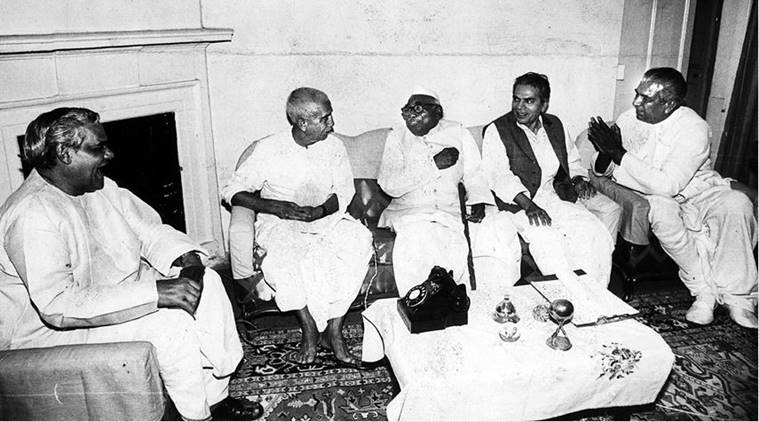 Vajpayee with Jagjivan Ram, Madhu Limaye, Charan Singh and Devi Lal at Singh’s residence in Delhi. (File)
Vajpayee with Jagjivan Ram, Madhu Limaye, Charan Singh and Devi Lal at Singh’s residence in Delhi. (File)
IF THERE is one significant contribution to the agriculture sector for which Atal Bihari Vajpayee will be remembered, it is his government’s Kisan Credit Card (KCC) scheme of 1998 that revolutionised bank lending to farmers for their crop production needs.
Till the advent of KCC, farmers had to apply for fresh loans ahead of every cropping season. There was no guarantee of these loans getting sanctioned on time — when required for financing their cultivation expenses towards seed, fertiliser, pesticide, fuel and labour or even post-harvest and marketing operations.
That changed with KCC, which was similar to a revolving cash credit facility traditionally availed from banks by industrialists and traders. The new crop loan product — announced in June 1998 as part of the then Finance Minister Yashwant Sinha’s Union Budget proposals and formally launched in August 1998 — did away with seasonal appraisals. Instead, farmers were issued credit cards having three-year validity, which was further increased to five years in August 2004.
The credit limit under KCC was linked to a farmer’s landholding size and the estimated scale of finance per acre for the crops grown by him. Once the credit limit was sanctioned, the farmer had the freedom to make any number of drawals and repayments within that limit. In short, while the bank fixed how much a farmer could borrow, the decision of when to draw that amount was entirely left to him.
“There was lot of resistance to the idea (of a cash credit limit-based working capital facility for farmers) from the Finance Ministry and the Reserve Bank of India, but the Prime Minister (Vajpayee) was fully convinced about it and directed my ministry to liaise with the banks. They were, in fact, very open to introducing such a product,” recalled Sompal Shastri, who was Union Minister of State for Agriculture during 1998-99.
While the credit cards issued had three-year validity (later five years), farmers were required to repay the borrowed amount along with interest within 12 months. But even this money needed to be deposited with banks only for 24 hours, before it could be withdrawn afresh. “The fact that the loans were to be squared off once a year (before January 31 if taken for the kharif season and July 31 for rabi), besides being extended against the security of the crop and land, gave banks confidence about the scheme,” Shastri said.
An indicator of KCC’s success is that the cumulative cards issued had reached 4.14 crore by March 31, 2004 towards the end of the Vajpayee government’s tenure. As on March 31, 2017, the total number of operative/live cards were 7.15 crore — more than half of India’s estimated 13.83 crore land holdings — with an outstanding sanctioned amount of Rs 372,740 crore.
KCC apart, Shastri identified the National Agricultural Insurance Scheme (the country’s first comprehensive insurance programme, covering most crops and both loanee and non-loanee farmers, introduced in rabi 1999) and de-licencing of the sugar industry, along with reduction in the minimum distance requirement between two factories from 25 to 15 km, as major pro-farmer initiatives of the Vajpayee-led NDA government.
The other important rural programme that was again a Vajpayee government baby was the Pradhan Mantri Gram Sadak Yojana (PMGSY). Launched in December 2000 and financed largely through a 50-paise-per-litre cess on diesel — raised to 75 paise in the 2003-04 Budget — this was a programme that aimed at providing all-weather road connectivity to every rural habitation with a minimum population of 500 in the plains and 250-plus in hill states, tribal districts and desert areas.
The fact that subsequent governments — whether of the UPA or the Modi-led NDA — have continued with KCC and PMGSY is the best tribute to what were originally conceived during Vajpayee’s time. And the Modi government’s Pradhan Mantri Fasal Bima Yojana hasn’t so far delivered results vastly superior to the National Agricultural Insurance Scheme.